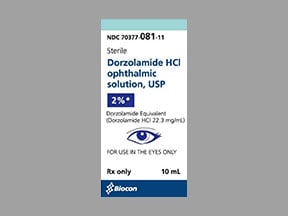
Dorzolamide Coupons & Savings Card – Discount Prices from $17.59
Generic for: Trusopt
My prescription
Edit
10ML of 2%, Dorzolamide (1 Bottle)
Select pharmacy

CVS
$22.73
COUPON PRICE
Walgreens
$17.59
COUPON PRICE
Albertsons
$19.08
COUPON PRICE
Walmart
$24.11
COUPON PRICEDorzolamide savings card
Show this card to your pharmacist
Walgreens
$17.59
BIN
ID
PCN
GRP
015995
LHFA890003
GDC
GDRX
Powered by
More prescriptions for glaucoma
More prescriptions for glaucoma
Price history for Trusopt (brand) & Dorzolamide (generic)
1 Bottle, 10ML of 2%
Average retail price for Trusopt
Average retail price for Dorzolamide
Average SaveHealth price for Dorzolamide
Our price history data is based on aggregated prescription data collected from participating pharmacies in America. Our prescription data updates daily to reflect the latest price changes. If you notice a missing data point, it means there wasn't sufficient data available to generate a monetary value for that date.
We analyzed Dorzolamide prices for (10ML of 2%, 1 Bottle) over the last 12 months. The average retail price was $198.64, while the average price using the SaveHealth discount card was $24.65. That's a savings of approximately 87.59% when using our Dorzolamide coupon.
Compared to the generic version, Trusopt had an average price of $116.20 over the same time period. With the SaveHealth savings card, Dorzolamide is 78.79% cheaper on average than Trusopt.
*Retail prices are based on pharmacy claims data, and may not be accurate when we don't have enough claims.
Dorzolamide dosage forms
Dosage Quantity Price from Per unit 1GM 1 Bottle $139.31 $139.31 1GM 2 Bottles $297.60 $148.80 1GM 3 Bottles $455.90 $151.97 10ML of 2% 1 Bottle $18.54 $18.54 10ML of 2% 2 Bottles $35.16 $17.58 10ML of 2% 3 Bottles $39.58 $13.19
| Dosage | Quantity | Price from | Per unit |
|---|---|---|---|
| 1GM | 1 Bottle | $139.31 | $139.31 |
| 1GM | 2 Bottles | $297.60 | $148.80 |
| 1GM | 3 Bottles | $455.90 | $151.97 |
| 10ML of 2% | 1 Bottle | $18.54 | $18.54 |
| 10ML of 2% | 2 Bottles | $35.16 | $17.58 |
| 10ML of 2% | 3 Bottles | $39.58 | $13.19 |
Dorzolamide Warnings
The following safety guidelines are essential to ensure the safe use of the medication dorzolamide. Please read them thoroughly and consult your healthcare provider with any questions or concerns.
Severe Allergic Reactions: Although primarily absorbed through the eye, a small amount of dorzolamide may enter the bloodstream. If you have a known allergy to sulfa medications, be aware that dorzolamide is a sulfa-based drug, and you may experience a severe allergic reaction. Seek immediate medical attention if you notice symptoms such as difficulty breathing, skin rash, redness, itching, or swelling. Alert your healthcare provider if you experience irritation, pain, or itching in or around your eyes. Risk: Sulfa allergy.
Risk of Eye Infection Due to Contamination: To prevent contamination, wash your hands before each application of dorzolamide. Avoid letting the bottle tip contact your eye or any surface, and do not touch the dropper tip with your hands. Contaminated medication can lead to eye infections, like bacterial keratitis, which is an infection of the cornea. Risk: Corneal disease, injury, or damage to the eye surface.
Risk of Corneal Swelling: Dorzolamide may increase the risk of corneal swelling (corneal edema) in certain individuals. If you have been informed by an eye specialist that your cornea is thin or you have a low number of cells on the cornea, discuss these conditions with your eye specialist before starting dorzolamide. Risk: Low number of cells on the cornea.
There are no contraindications available for this medication. Always adhere to the prescribed guidelines and consult your healthcare provider for personalized advice.
Dorzolamide Side Effects
Common side effects:
- Temporary blurred vision
- Burning of the eye
- Stinging of the eye
- Redness of the eye
- Itching
- Watery eyes
- Dry eyes
- Sensitivity to light
- Bitter taste
- Headaches
Less common but important to monitor:
- Bacterial eye infections
- Allergic reactions in the eye
- Eyelid irritation
- Pink eye
Serious side effects:
- Vision changes
- Symptoms of kidney stones
- Yellowing of the skin or eyes
- Dark urine
- Unusual tiredness
- Signs of infection
- Severe allergic reactions
- Eye redness or discharge
- Eye or eyelid swelling
- Difficulty breathing
Dorzolamide Interactions
When using dorzolamide eye drops, it's important to be aware of potential interactions with other medications and certain health conditions. Dorzolamide is a carbonic anhydrase inhibitor that reduces intraocular pressure by decreasing fluid production in the eye.
Drug Interactions:
Oral Carbonic Anhydrase Inhibitors: Combining dorzolamide with oral carbonic anhydrase inhibitors like Acetazolamide or Methazolamide can increase the risk of side effects.
Salicylates: Medications containing salicylates, such as Aspirin or Bismuth Subsalicylate, may interact with dorzolamide, potentially leading to metabolic acidosis.
Disease Interactions:
Kidney and Liver Conditions: Individuals with severe kidney or liver disease should use dorzolamide cautiously, as the medication is processed through these organs.
Sulfonamide Allergy: Dorzolamide is a sulfonamide derivative. Those with a known sulfonamide allergy may experience allergic reactions and should consult their healthcare provider before use.
Blood Disorders: Patients with blood dyscrasias or bone marrow suppression should be cautious, as sulfonamides can be systemically absorbed and may cause hematologic toxicity.
Porphyria: Individuals with porphyria should use dorzolamide with caution, as sulfonamides can precipitate an acute attack.
Always inform your healthcare provider about all medications you're taking and any existing health conditions to ensure dorzolamide is safe and effective for you.
